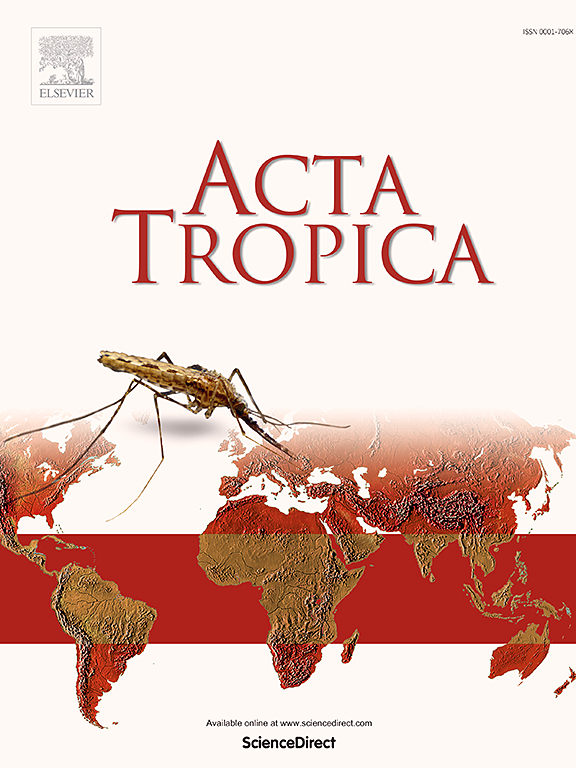Role of sja-let-7 in egg production and reproductive development in female Schistosoma japonicum
IF 2.1
3区 医学
Q2 PARASITOLOGY
引用次数: 0
Abstract
Schistosoma japonicum, a parasitic flatworm, exhibits the special biological phenomenon of male-female pairing, essential for the reproductive maturation and egg production of female worms. MicroRNAs (miRNAs) are known to regulate female reproductive development, yet the roles of individual miRNAs in schistosome reproduction remain poorly defined. Among them, the conserved let-7 family, identified in S. japonicum as early as 2008, has not been explored for its specific biological functions. Expression profiling of sja-let-7 was first conducted across multiple datasets and validated through qPCR. Bioinformatic tools were used to predict sja-let-7 target genes, and fluorescence in situ hybridization (FISH) was employed to determine sja-let-7 localization in reproductive organs. Functional studies involving sja-let-7 modulation through mimics and inhibitors in vitro, and agomir and antagomir treatments in vivo, were conducted to evaluate its impact on female reproductive development, target gene regulation, and egg production. Results showed that sja-let-7 demonstrated prominent localization in the Mehlis’ gland, ovaries, and vitellaria of female. Sjcdc23, a potential target gene of sja-let-7, was implicated to play a potential role in reproductive processes of schistosomes. Overexpression or inhibition of sja-let-7 significantly impaired egg production and quality in vitro. In vivo experiments demonstrated disrupted vitellaria development and reduced egg production in agomir-treated worms, while antagomir treatment also decreased egg production, suggesting that sja-let-7 is crucial for female reproductive development and egg-laying capacity, providing novel insights into miRNA-mediated regulatory mechanisms in parasitic helminths.

sja-let-7在日本血吸虫雌虫产卵和生殖发育中的作用
日本血吸虫(Schistosoma japonicum)是一种寄生扁形虫,雌雄配对是雌虫生殖成熟和产卵的重要生理现象。众所周知,MicroRNAs (miRNAs)可以调节女性生殖发育,但个体miRNAs在血吸虫生殖中的作用仍不明确。其中,保守的let-7家族早在2008年就在日本血吸虫中被发现,但尚未对其具体的生物学功能进行探索。sja-let-7的表达谱首先在多个数据集上进行,并通过qPCR进行验证。利用生物信息学工具预测sja-let-7靶基因,采用荧光原位杂交(FISH)技术确定sja-let-7在生殖器官中的定位。通过体外模拟物和抑制剂调控sja-let-7,以及体内阿戈米和安塔戈米治疗sja-let-7的功能研究,评估其对女性生殖发育、靶基因调控和产卵的影响。结果表明,Sja-let-7在雌性梅氏腺、卵巢和卵黄中有明显的定位。Sjcdc23是sja-let-7的潜在靶基因,可能在血吸虫的生殖过程中发挥潜在作用。sja-let-7的过表达或抑制显著影响体外卵子产量和质量。体内实验表明,阿戈莫治疗的蠕虫卵黄发育被破坏,产蛋量减少,而安塔戈莫治疗也减少了产蛋量,这表明sja-let-7对雌性生殖发育和产卵能力至关重要,为寄生蠕虫mirna介导的调节机制提供了新的见解。
本文章由计算机程序翻译,如有差异,请以英文原文为准。
求助全文
约1分钟内获得全文
求助全文
来源期刊

Acta tropica
医学-寄生虫学
CiteScore
5.40
自引率
11.10%
发文量
383
审稿时长
37 days
期刊介绍:
Acta Tropica, is an international journal on infectious diseases that covers public health sciences and biomedical research with particular emphasis on topics relevant to human and animal health in the tropics and the subtropics.
 求助内容:
求助内容: 应助结果提醒方式:
应助结果提醒方式:


